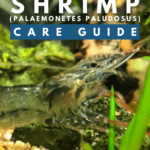Ghost shrimp (Palaemonetes paludosus) or Glass shrimp can make an excellent addition to a peaceful community tank.
As well as providing an interesting alternative to fish, these busy invertebrates help to keep your tank neat and tidy, scavenging detritus and waste from the substrate and grazing on algae.
But do you need to feed them, and if so, what do Ghost shrimp eat? What kind of aquarium filter system is safest for a tank containing Ghost shrimp? And, can Glass shrimp live with goldfish?
Read this complete care guide for the answers to these questions and lots more!
Ghost Shrimp – Species Profile
Scientific Name
Palaemonetes paludosus
Common Names
Ghost shrimp, Glass shrimp, Eastern Grass shrimp, Riverine Grass shrimp
Family
Origin
North America
Diet
Omnivore
Care Level
Easy
Activity
Active scavenger
Lifespan
Up to 1 year
Temperament
Peaceful
Tank Level
Mostly bottom-dwellers
Minimum Tank Size
5 to 10 gallons
Temperature Range
65o to 82o F
Water Hardness
8 to 12 dKH
pH Range
7.0 to 8.0
Filtration/Flow Rate
Gentle flow rate, well-filtered
Water type
Freshwater
Breeding
Egg-layers. Fairly easy to breed in the home tank
Compatibility
Small, non-aggressive fish
Plant-safe?
Yes
Origins and Habitat
They were first described in 1850 by Gibbes and are native to North America.
The shrimp live in lakes and rivers where the substrate is soft and silty, and there are plenty of places to hide.
These little crustaceans are often used by fishermen as bait and have widely colonized clam farms where they are regarded as pests.
In nature and captivity, Glass shrimp spend much of their time foraging for scraps within reach of the safety of burrows that they dig in the substrate.
What Do Glass Shrimps Look Like?

The Glass or Ghost shrimp’s name is a dead giveaway when it comes to the creature’s appearance! They are completely transparent in color, which allows you to see the crustaceans’ inner physiology, making fascinating viewing. However, you may notice that individual shrimp have dots of various colors on their backs.
Ghost shrimp have one short and one long pair of antennae on their head that the creatures use to detect particles of food or toxins in the water. It’s thought that the antennae are also used for some kind of social or communication purpose, although the precise nature of that is not fully understood.
Between the shrimp’s eyes in front of its body is a beak-like extension called a rostrum. A hard shell or carapace protects the creature’s soft body. Behind that are six flexible segments comprising the shrimp’s abdomen and housing the animal’s pleopods used to propel the shrimp through the water.
The tail is connected to the sixth abdominal segment that terminates in the shrimp’s characteristic fan shape.
How Big Are Glass Shrimps?

They typically grow to around 1.5 inches, females being larger than males.
That’s good news for hobbyists, as it means you can add quite a few of these guys to your tank without compromising water quality since the shrimps’ bioload is so small.
How Long Do Ghost Shrimp Live?
The main drawback of these shrimp is that they only have a very short lifespan, typically just one year or perhaps a little longer in some cases.
As they are very easy to breed and keep, they are commonly used to feed large fish species in the home aquarium. Consequently, the shrimp are often raised in overcrowded tanks with poor water quality. That increases their mortality rate, even if they are housed in a healthy tank.
Do Glass Shrimp Molt?
Yes, all shrimp species molt regardless of their lifespan.
The shrimp’s hard carapace doesn’t grow, but the shrimp inside it does. So, the shrimp must shed its old shell and grow a new one. The frequency of molting depends on the quality of the shrimp’s diet and, therefore, how quickly it grows.
Immediately before and after molting, the shrimp will hide while it’s vulnerable, only emerging when the shell has hardened.
If you see a molted shell in the tank, leave it there for a few days, as the shrimp often eat the shell for the calcium and other minerals it contains.
Gender Differences
If you’re planning on breeding your shrimp, which is a great idea given that they have such short lives, you need a good mixture of males and females.
Sexing juvenile shrimp is extremely difficult. However, adult males are usually slightly smaller than females, and you will see female shrimp carrying eggs in a green belly saddle when in breeding condition.
Temperament and Activity Level
Ghost shrimp are scavengers, eating any leftover fish food in the aquarium and grazing on algae growing on the substrate or tank decorations.
They are active throughout the daytime, and they navigate the tank either by free-swimming around the tank or scuttling about on the substrate.
What Are Good Tank Mates for Glass Shrimp?
There are plenty of suitable tank mates for Glass shrimp.
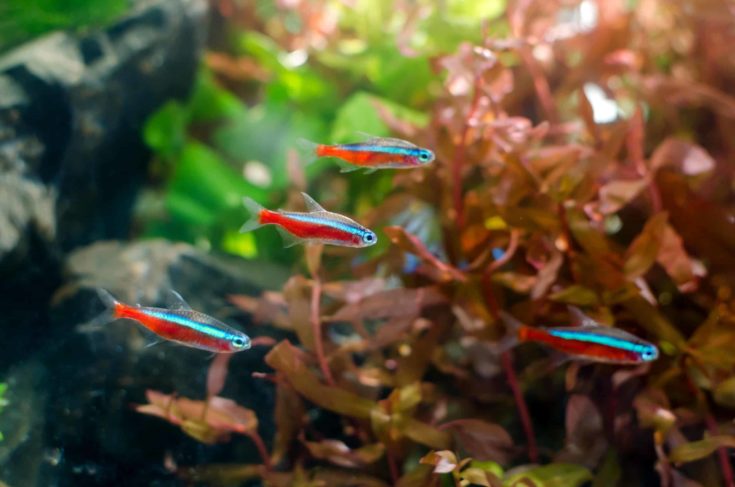
Basically, any small peaceful fish should do fine with Ghost shrimp, including Neon tetras, Corydoras catfish, and similar peaceful bottom-dwellers. You can also keep other shrimp species such as Cherry shrimp or Bamboo shrimp with Ghost shrimp. Snails make good tank mates, too.
See also: Whisker Shrimp Vs Ghost Shrimp: What’s The Difference?
Fish Species to Avoid
When it comes to what fish species you should not keep with Ghost shrimp, I recommend that you avoid any fish that has a mouth large enough to fit a shrimp! For example, Discus, Oscars, large cichlids, and goldfish will all make a meal of a Ghost shrimp.
Can I Keep Ghost Shrimp in Groups?
They can be kept in isolation, but they do seem to prefer having a few of their own species for company in a tank, probably applying the safety in numbers principle.
What Do Ghost Shrimp Eat?
When it comes to feeding them, Ghost shrimp are extremely easy to cater for!
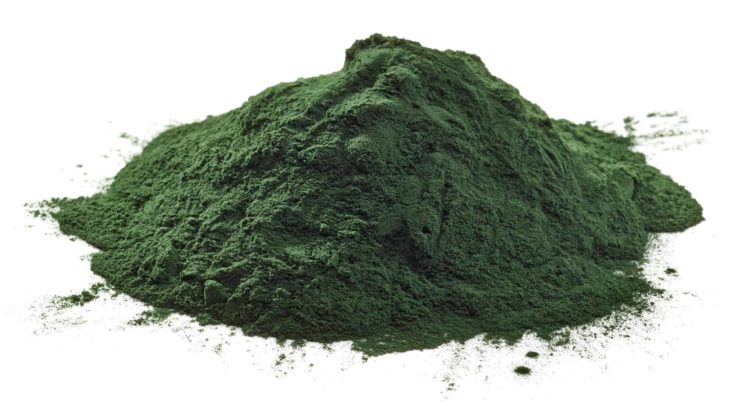
Basically, these opportunistic scavengers will eat anything that they find while scavenging in the tank. That includes plant matter, algae, leftover fish food, and general detritus.
However, to make sure that your shrimp don’t go hungry, especially if you have a large group in the tank, I recommend that you offer your shrimp algae wafers, too.
How Often and How Much to Feed Ghost Shrimp
If the shrimp appear to be getting plenty of food from their environment, you only need to add one algae wafer every day to keep them happy.
Tank Requirements
Tank size
The tiny Ghost shrimp is ideal for a 5-gallon nano tank, although if you want to keep a big group, you’ll need a larger tank.
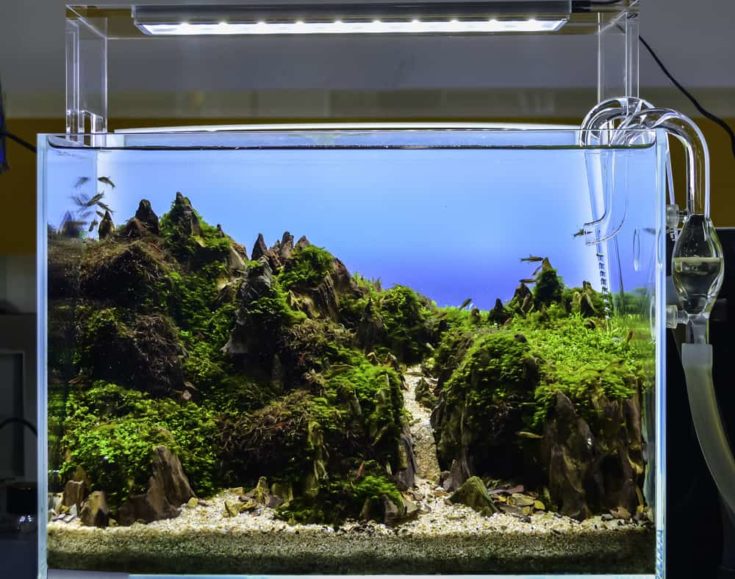
As a general rule, you can keep around three or four Glass shrimp per gallon of water. However, these little critters breed very readily, and you could soon end up with a population explosion.
Tank Setup
Substrate
Ghost shrimp like to make burrows that they use for shelter. So, a soft, sandy substrate is the best choice as it’s easy for them to get through it without damaging their sensitive antenna.
Another advantage of using sand over gravel is that leftover food, plant debris, and general waste tend to sit on top of the substrate. That provides easy pickings for the shrimp and makes your maintenance job easier too.
Decoration
Ghost shrimp do well in densely planted aquariums that have lots of busy plants, overhangs, and caves that the shrimp can shelter in, especially during molting.
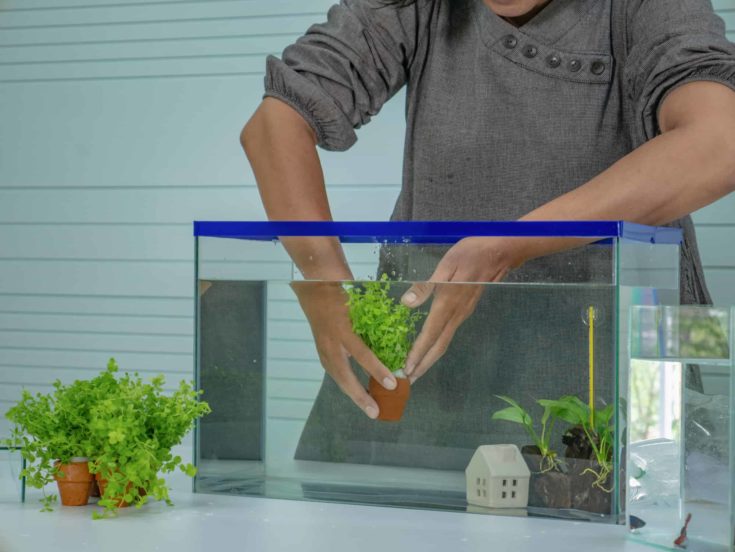
Pieces of driftwood and twisted roots can make a nice addition to your aquascaping, adding to the tank’s aesthetic and offering hideouts for them. Also, wood provides the ideal surface for algae, which they will eat.
Water Quality
Filtration
Good water quality is important if you want to keep them healthy and make the most of their short lifespan. A gentle flow of water through the tank that your filtration system generates is fine, or you could add an air stone, too, if you want to.
Shrimp are tiny, delicate creatures that could easily be sucked into a filter inlet pipe unless you fit a small piece of thin sponge to the pipe. So, when choosing a filter system for a shrimp tank, I recommend that you use a sponge filter to prevent accidents.
Water Parameters
Water Temperature
Ghost shrimp aren’t fussy when it comes to temperatures, and they can tolerate a range between 65ºF and 82ºF.
That’s handy if you have a cold water tank, as the shrimp can live in water at room temperature. Also, if you live in a warm climate, you most likely won’t need a heater for a shrimp tank.
Water Hardness and pH Range
The pH level should be in the range of 7.0 to 8.0, and the water should be on the hard side.
Lighting
When choosing lighting for your tank, focus on what you need to keep the plants healthy and growing well. Ghost shrimp don’t have any particular requirements when it comes to lighting.
Aquarium Maintenance
If you’re keeping them purely as feeder fish for your other livestock, you don’t need to be quite so rigorous about your tank maintenance. However, from a welfare perspective, you should keep the tank clean and hygienic.

- Carry out partial water changes of around 30% each week.
- Test the water each week to see that ammonia and nitrite levels are zero and nitrates are 20ppm or lower.
- Rinse the filter media in tank water once a month or so to remove detritus that could otherwise clog the sponges. Replace the media regularly as per the manufacturer’s recommendations.
- Be sure to deep-clean the substrate, tank corners, between the bases of plants, and under decorations, using an aquarium vacuum cleaner to remove debris and detritus.
- Trim dead leaves from plants and thin out overgrowth as necessary.
How To Set Up A Tank For Ghost Shrimp
Setting up a fish tank is much quicker if you take a few moments before you start to gather everything you need:
- LED light unit
- Sandy substrate
- Sponge filtration system
- Heater if required
- Driftwood, rocks, caves, twisted roots
- Plants
- Water dechlorinator
How To Set Up Your Freshwater Aquarium
- Start by washing the substrate to remove dust that would otherwise cloud the water.
- Add some substrate to the aquarium. An inch or two is usually fine for shrimp.
- Install the filter and heater if you’re using one. You don’t need to turn the units on just yet.
- Use tap water that you’ve treated with a dechlorinator to fill your aquarium. Don’t fill the tank right up to the fill line yet, as the water level will rise when you add your decorations and plants.
If you put an upside-down plate or dish on the substrate in the center of the tank and pour the water over that, the sand won’t get pushed all over the aquarium. - You can’t add any livestock to your tank until it’s cycled. To start the nitrogen cycle in your biological filter, you need to introduce some ammonia to the tank. To do that, you can use some substrate or filter media from a mature tank, add a pinch or two of fish flakes, or put a few drops of pure ammonia into the water.
Ammonia is necessary for nitrifying bacteria to colonize the tank. Those bacteria process the harmful toxins that are produced by decomposing fish waste and detritus, leaving the water safe for your fish and other livestock. - Next, wash the dust from your tank decorations and arrange everything in the tank as required.
- Arrange your plants in the aquarium, snipping off any brown leaves or damaged stems and allowing plenty of space between each plant so that it has room to grow.
- Turn on the sponge filtration system and the heater if needed. Plants require plenty of light for photosynthesis, so you need to set your aquarium lighting unit to come on for between eight and ten hours every day.
- Now, you have to wait for the tank to cycle, which usually takes around ten days or more. Test the tank water every few days to check the levels of ammonia, nitrites, and nitrates.
There should be zero ammonia and nitrites in the water, and the nitrates should be as close to 20ppm as possible before it’s safe to add your shrimp and fish.
Health and Disease
Ghost shrimp are quite hardy critters that don’t succumb to many diseases during their short lives. However, a few health conditions affect shrimp in general that you should be aware of.
Most of those illnesses can be treated with medication that you add to the water.
However, shrimp are extremely sensitive to copper, which is contained in many treatments. So, double-check that any product you add to your tank is shrimp-safe before you use it.
What To Look For In Healthy Glass Shrimp
Healthy Glass shrimp are active animals that spend most of the daylight hours scavenging on the bottom of the tank and occasionally swimming in the middle area of the water column.
The shrimp also like to dig burrows in the substrate that they use for shelter.
Shrimp that are about to molt often hide for a day or so before and after the process while they’re soft and vulnerable. If your shrimp disappears and doesn’t reemerge for a few days, check that the critter is still alive. Remove any casualties right away so that the body doesn’t decompose and pollute the water.
Signs of Ill Health
The following behaviors could spell trouble:
- Not eating
- Inactivity
- Hiding away and not reemerging for more than a couple of days
Common Ghost Shrimp Health Issues and Treatment
Health Issue
Vorticella
Symptoms or Causes
Vorticella appears as white mold on the shrimp’s head, body, and the end of the animal’s nose. A species of aquatic parasites cause the condition.
Suggested Action
Treat the tank with OTC antiparasitic medication.
Health Issue
Scutariella Japonica
Symptoms or Causes
Scutariella Japonica is a parasite that infects the gills and mantle of the shrimp. You may be able to see these flatworms attached to your shrimp.
Suggested Action
Treat the tank with OTC antiparasitic medication.
Health Issue
Bacterial infections
Symptoms or Causes
Bacterial infections usually target the shrimp’s internal organs, making it virtually impossible to detect a problem until the shrimp dies.
Suggested Action
Treat the tank with OTC antibacterial medication to protect the remaining shrimp.
Health Issue
Epibionts, Ellipsoid, Dinoflagellate
Symptoms or Causes
These are species of external parasites that usually appear as green, fluffy growths on the underside of the shrimp and between the legs. The condition is usually fatal unless you catch it very quickly.
Suggested Action
Treat the tank with OTC antiparasitic medication to protect the remaining shrimp.
Breeding
Unfortunately for the Ghost shrimp, they are very easy to breed in the home tank, so they are often used as feeder fish. However, given the Glass shrimp’s short lifespan, their ease of breeding is good news for you if you want to keep these pretty little shrimp as a cleanup crew in your aquarium.
Observe them in your main tank. Every two or three weeks, the female shrimp produce clutches of green-colored eggs, which you will see attached to the shrimp’s legs. Allow a few days for the male shrimp to fertilize the eggs, and then remove the “berried” females to the breeding tank to prevent predators from eating the baby shrimp as soon as they hatch.
Breeding Tank
The best way to raise Glass shrimp is to set up a separate breeding tank.
Use a sponge filter to prevent the youngsters from being sucked into the filtration system and set up the tank with a thin layer of sand and a few plants that will provide food for the juvenile ones.
The eggs usually take around three weeks to hatch. Once the eggs hatch, remove the females, or they will probably eat the eggs.
You’ll need to feed the shrimp larvae with tiny amounts of particle food to supplement what nutrition they derive from algae and plant debris. As soon as the larvae morph into baby shrimp, you can offer them the same food as you give to your adult Glass shrimp.
They are fully grown after around five weeks, and you can then move them into your main setup.
Availability
Glass shrimp are readily available in pretty much any fish store, or you can buy them online quite cheaply.
However, it’s worth asking the store assistant if the Ghost shrimp they’re selling are intended as feeder fish. If that’s the case, the shrimp have likely been raised in crowded, stressful conditions, and they might not last long once you get them home.
Shrimp Tank Product Index
- Aquarium siphon vacuum cleaner
- Sponge filtration unit
- Aquarium (5 gallons or more)
- Heater (if required)
- LED lighting unit
- Live plants
- Assorted aquarium decor
- Algae wafers and tropical fish flakes
- Sandy substrate
- Water dechlorinator
If you’re a shrimp-keeping newbie, I also suggest that you get yourself a book on raising shrimp.
In Conclusion
I hope you found our guide to keeping Ghost shrimp helpful.
Do you keep Ghost shrimp in your community aquarium? Tell us in the comments box below.
And remember to share this guide if you loved it!
